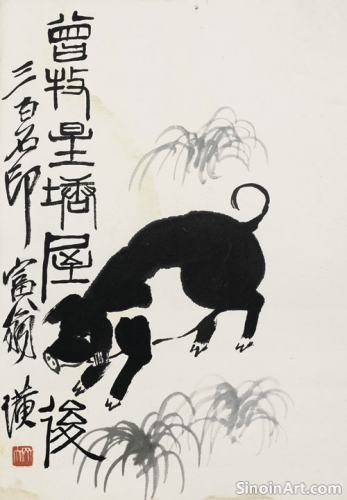Xieyi Painting and the Concept of "Yun Wei"
|
The term "Yun Wei" (韵味), often translated as "charm," "flavor," or "aftertaste," is an essential aesthetic quality in Xieyi painting, referring to the overall sense of feeling, emotion, and lingering impression that an artwork creates in the viewer. Yun Wei refers to the lasting impression the artwork leaves with the observer.  Yun Wei goes beyond mere visual appeal; it is a sense of subtle depth and expressiveness, a feeling that the artwork has something profound to communicate. It is the emotional and intellectual aftertaste, a lasting impression on the viewer. It is the power of suggestion and feeling.  Achieving Yun Wei requires a mastery of the techniques of ink and brush, as well as a deep understanding of the subject matter and the underlying emotions and concepts that the artist is trying to convey. It is a combination of skill, intent, and understanding. It is a result of both technical proficiency and a cultivated aesthetic sensibility.  Yun Wei often comes from the subtle variations in tone, texture, and line, as well as the interplay of ink and blank space, and the overall composition of the artwork. It is often found in the subtle details, the small choices that all add to the overall effect. It is these subtle nuances that create the painting’s enduring charm. Ultimately, Yun Wei is an intangible quality, something that is experienced rather than simply seen. It is the power of art to resonate with the viewer, leaving a lasting impression that goes beyond the surface appearance. It is the goal of all artists, to create something that will linger in the mind of the viewer. |
Tag : art charm, aesthetic flavor, lingering impression, Xieyi feeling
Related information
- The Influence of Taoism on Xieyi Painting
- Xieyi Flowers and Birds: Expressing Life’s Vitality
- The Symbolism of Xieyi: Expressing Inner Worlds
- Learning Xieyi Painting: A Path of Practice
- The Significance of Composition in Xieyi
Taoism, with its emphasis on living in harmony with nature, has significantly influenced the development of Xieyi painting. The Taoist concept of the Tao (道), the underlying principle of the universe, is reflected in the ways that Xieyi artists capture the flow of life.
The depiction of flowers and birds (花鸟画, huaniao hua) is another important theme in Xieyi painting, serving as a way to express life's vitality and beauty. Artists seek not just to portray the outward appearance of these subjects, but also to convey their inherent energy and spirit.
This article explores the symbolic elements within Xieyi painting, focusing on how subjects, composition, and brushwork contribute to the expression of the artist's inner world and cultural values.
Learning Xieyi painting involves mastering basic brushstrokes, observation of nature, studying old masters, developing a personal style, and cultivating patience and persistence. It is a process that blends technical skill with personal growth and understanding.
Composition, including the strategic use of negative space, asymmetrical balance, and flowing lines, is vital in Xieyi painting, guiding the viewer's eye, creating a sense of harmony, and supporting the artist's intention, despite the art form's seemingly spontaneous nature.